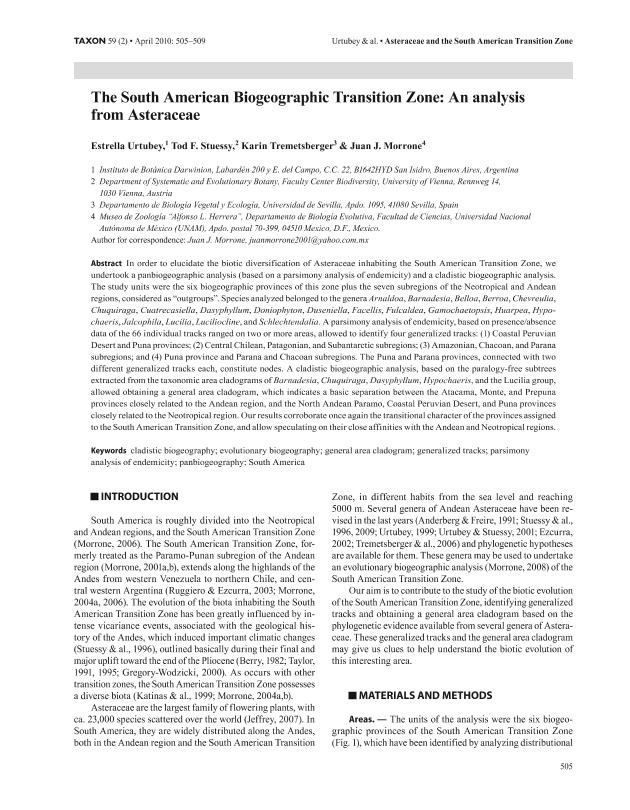Mostrar el registro sencillo del ítem
dc.contributor.author
Urtubey, Estrella

dc.contributor.author
Stuessy, Tod F.
dc.contributor.author
Tremetsberger, Karin
dc.contributor.author
Morrone, Juan José

dc.date.available
2019-01-24T21:18:53Z
dc.date.issued
2010-04
dc.identifier.citation
Urtubey, Estrella; Stuessy, Tod F.; Tremetsberger, Karin; Morrone, Juan José; The South American Biogeographic Transition Zone: An analysis from Asteraceae
; International Association for Plant Taxonomy; Taxon; 59; 2; 4-2010; 505-509
dc.identifier.issn
0040-0262
dc.identifier.uri
http://hdl.handle.net/11336/68600
dc.description.abstract
In order to elucidate the biotic diversification of Asteraceae inhabiting the South American Transition Zone, we undertook a panbiogeographic analysis (based on a parsimony analysis of endemicity) and a cladistic biogeographic analysis. The study units were the six biogeographic provinces of this zone plus the seven subregions of the Neotropical and Andean regions, considered as “outgroups”. Species analyzed belonged to the genera Arnaldoa, Barnadesia, Belloa, Berroa, Chevreulia, Chuquiraga, Cuatrecasiella, Dasyphyllum, Doniophyton, Duseniella, Facellis, Fulcaldea, Gamochaetopsis, Huarpea, Hypochaeris, Jalcophila, Lucilia, Luciliocline, and Schlechtendalia. A parsimony analysis of endemicity, based on presence/absence data of the 66 individual tracks ranged on two or more areas, allowed to identify four generalized tracks: (1) Coastal Peruvian Desert and Puna provinces; (2) Central Chilean, Patagonian, and Subantarctic subregions; (3) Amazonian, Chacoan, and Parana subregions; and (4) Puna province and Parana and Chacoan subregions. The Puna and Parana provinces, connected with two different generalized tracks each, constitute nodes. A cladistic biogeographic analysis, based on the paralogy–free subtrees extracted from the taxonomic area cladograms of Barnadesia, Chuquiraga, Dasyphyllum, Hypochaeris, and the Lucilia group, allowed obtaining a general area cladogram, which indicates a basic separation between the Atacama, Monte, and Prepuna provinces closely related to the Andean region, and the North Andean Paramo, Coastal Peruvian Desert, and Puna provinces closely related to the Neotropical region. Our results corroborate once again the transitional character of the provinces assigned to the South American Transition Zone, and allow speculating on their close affinities with the Andean and Neotropical regions.
dc.format
application/pdf
dc.language.iso
eng
dc.publisher
International Association for Plant Taxonomy

dc.rights
info:eu-repo/semantics/openAccess
dc.rights.uri
https://creativecommons.org/licenses/by-nc-sa/2.5/ar/
dc.subject
Asteraceae
dc.subject
Cladistic Biogeography
dc.subject
Evolutionary Biogeography
dc.subject
Panbigeography
dc.subject.classification
Otras Ciencias de la Tierra y relacionadas con el Medio Ambiente

dc.subject.classification
Ciencias de la Tierra y relacionadas con el Medio Ambiente

dc.subject.classification
CIENCIAS NATURALES Y EXACTAS

dc.title
The South American Biogeographic Transition Zone: An analysis from Asteraceae
dc.type
info:eu-repo/semantics/article
dc.type
info:ar-repo/semantics/artículo
dc.type
info:eu-repo/semantics/publishedVersion
dc.date.updated
2019-01-24T18:49:43Z
dc.journal.volume
59
dc.journal.number
2
dc.journal.pagination
505-509
dc.journal.pais
Austria

dc.description.fil
Fil: Urtubey, Estrella. Consejo Nacional de Investigaciones Científicas y Técnicas. Instituto de Botánica Darwinion. Academia Nacional de Ciencias Exactas, Físicas y Naturales. Instituto de Botánica Darwinion; Argentina
dc.description.fil
Fil: Stuessy, Tod F.. Universidad de Viena; Austria
dc.description.fil
Fil: Tremetsberger, Karin. Universidad de Sevilla; España
dc.description.fil
Fil: Morrone, Juan José. Universidad Nacional Autónoma de México; México
dc.journal.title
Taxon

dc.relation.alternativeid
info:eu-repo/semantics/altIdentifier/url/https://onlinelibrary.wiley.com/doi/10.1002/tax.592015
dc.relation.alternativeid
info:eu-repo/semantics/altIdentifier/doi/http://dx.doi.org/10.1002/tax.592015
Archivos asociados
